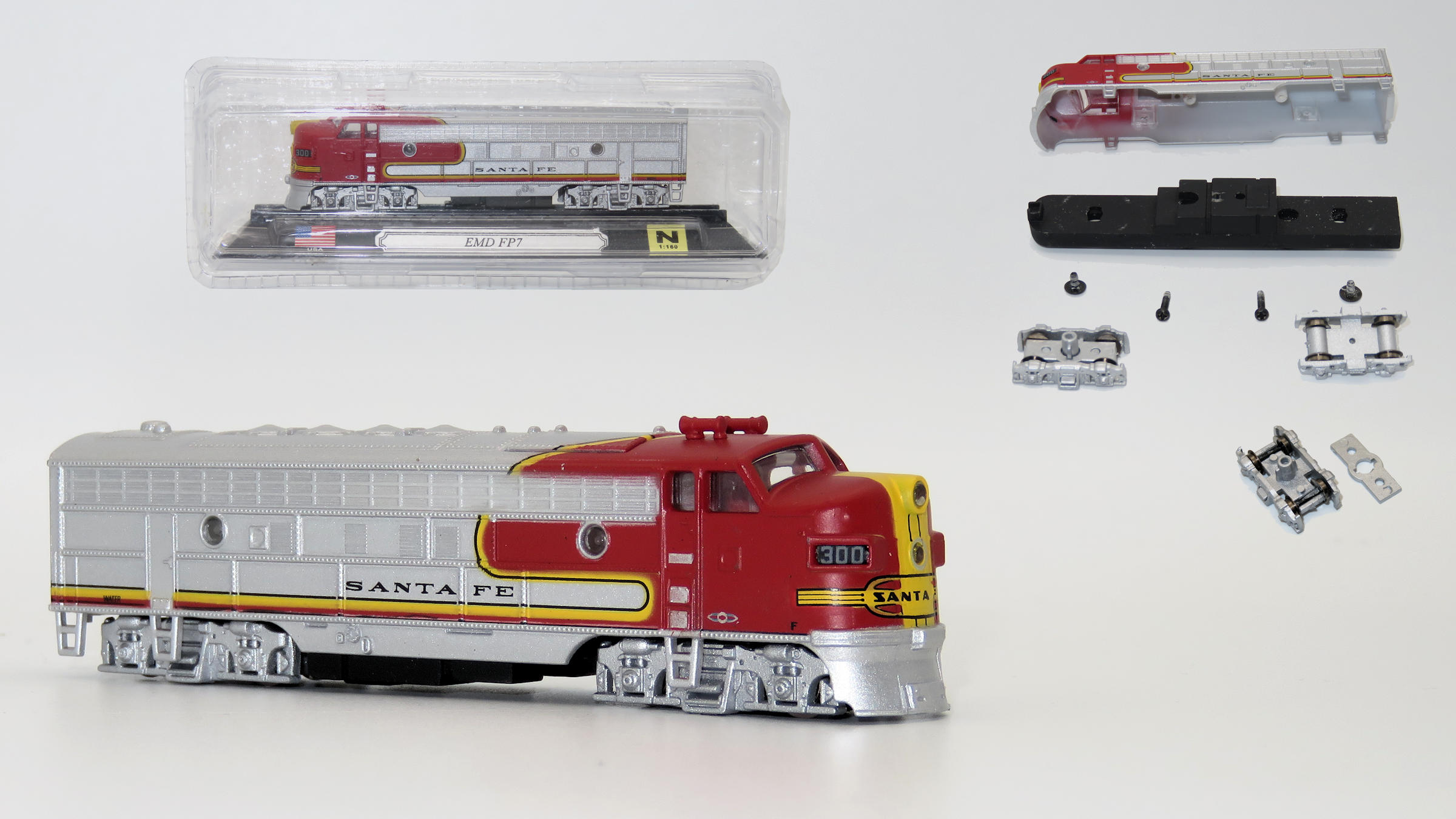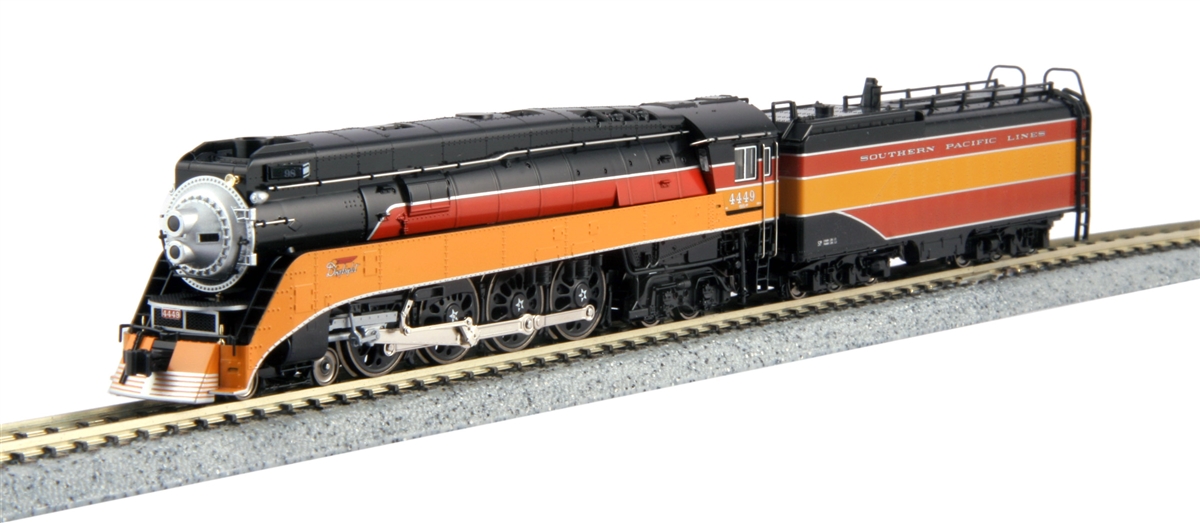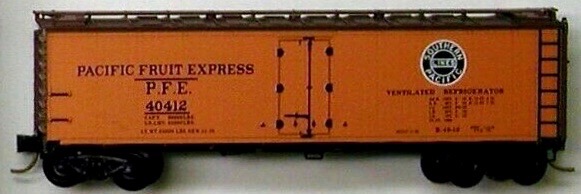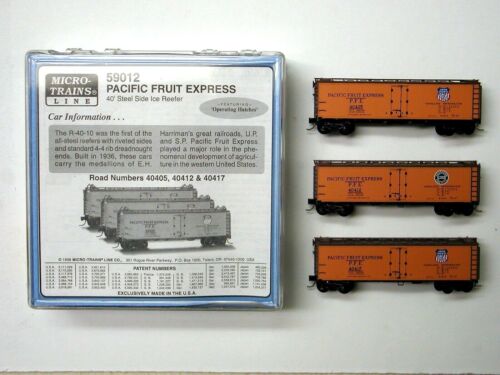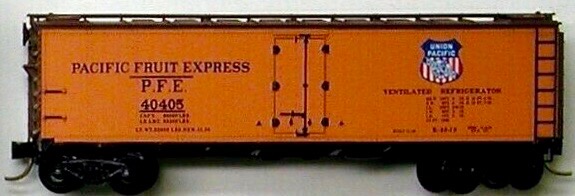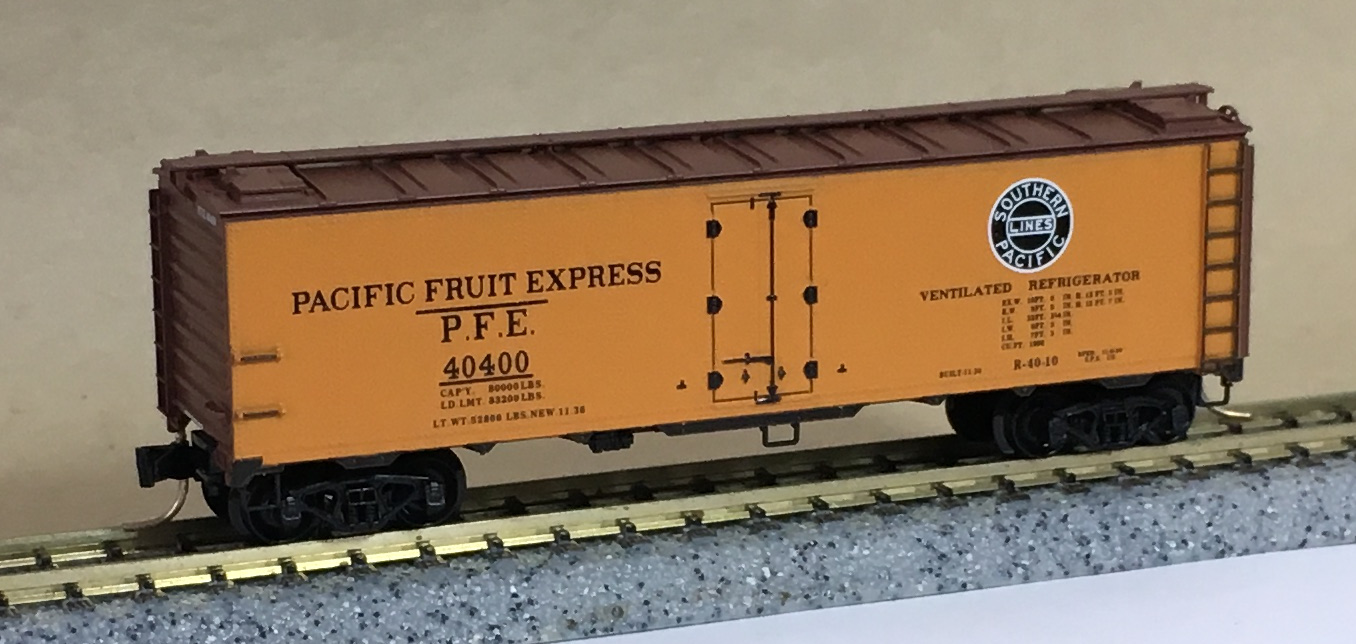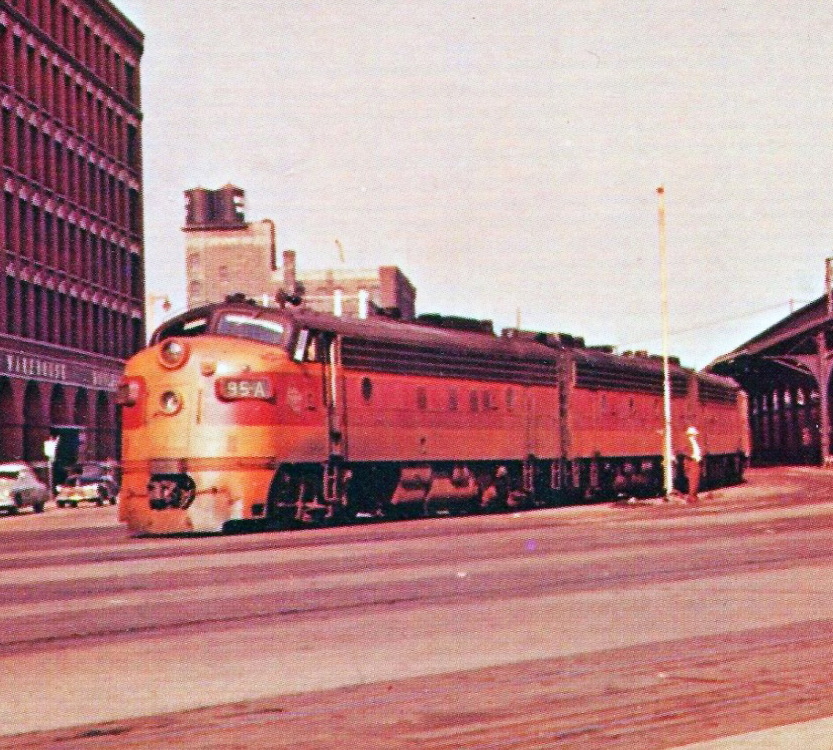Series Information: Locomotives of the World is a series of 100 dummy N gauge locomotives, for display only, released by Del Prado Editions in various countries, from 2005 to 2007. The don't have operating axles nor operating couplers, so they really are just nicely painted paperweights.
The models were released one at a time every week, but not at the same time and not in the same order in each country. We are using here the numbering of the Italian edition, based on this source.
The models were released one at a time every week, but not at the same time and not in the same order in each country. We are using here the numbering of the Italian edition, based on this source.
Model Information: The unpowered display model of the EMD FP7 appeared in the collectible series Locomotives of the World from the Del Prado publishing house. In Europe as a Union Pacific model, in the USA also in the Warbonnet livery of the Santa Fe. The nicely shaped plastic body is screwed to a metal frame, the two movable bogies are also screwed on. All screws are covered with locking varnish. The warning on the packaging "Do not place on powered track, metal wheels will cause short circuit" is not correct. The wheels have plastic axles and will not cause a short circuit. The two-piece and for such a model quite detailed bogies are glued together. Unfortunately, some of the axles have been glued as well, so the model does not roll. The model has no couplers, but the metal frame has at least a front mount for a coupler. The weight of the model is 77 grams.
For an inexpensive display model, the shell is surprisingly nicely done. At first sight it seems to be a copy of the modeler version of the metal case of the FP7 from Model Power, but in detail it shows some differences, e.g. in the design of the ventilation grills, the strongly simplified sand fillers and the roof superstructure of the steam generator. This is the version without Dynamic Brakes. A cover is inserted into the roof at the appropriate place, just like on Model Power FP7. The roof vents are a bit simple, the replicated rivets are much too large. The two signal horns are attached, the number boards inserted. Except for the window of the rear door, all windows are glazed.
The colors of the Santa Fe model are very nice, but the paint job is not always very accurate. Small details that are only noticeable on close inspection, such as the WATER lettering, have also been printed on. The lower front headlight was provided with a silver ring, this gives a very nice front view. The paint job of the Union Pacific model is not so nice, because here the yellow is just solid colored plastic.
The Santa Fe FP7 is quite suitable for standing in the depot of a model railroad layout and will only be noticed on closer inspection due to the missing coupler as a cheap display model. The Union Pacific model is unfortunately unsuitable due to the colored and unpainted yellow plastic.
The Union Pacific FP7 model was also available in the collectible series of the Spanish Club Internacional del Libro (CIL) and in the series Reisen auf Schienen of the German Weltbild-Verlag. Both of these series featured a dummy knuckle coupler on the front end and a Rapido coupler on the rear end.
Del Prado and CIL shipped the locomotive in blister packaging and bolted to a short piece of track, while Weltbild-Verlag shipped it in cardboard packaging. All three came with a short description of the prototype.
For an inexpensive display model, the shell is surprisingly nicely done. At first sight it seems to be a copy of the modeler version of the metal case of the FP7 from Model Power, but in detail it shows some differences, e.g. in the design of the ventilation grills, the strongly simplified sand fillers and the roof superstructure of the steam generator. This is the version without Dynamic Brakes. A cover is inserted into the roof at the appropriate place, just like on Model Power FP7. The roof vents are a bit simple, the replicated rivets are much too large. The two signal horns are attached, the number boards inserted. Except for the window of the rear door, all windows are glazed.
The colors of the Santa Fe model are very nice, but the paint job is not always very accurate. Small details that are only noticeable on close inspection, such as the WATER lettering, have also been printed on. The lower front headlight was provided with a silver ring, this gives a very nice front view. The paint job of the Union Pacific model is not so nice, because here the yellow is just solid colored plastic.
The Santa Fe FP7 is quite suitable for standing in the depot of a model railroad layout and will only be noticed on closer inspection due to the missing coupler as a cheap display model. The Union Pacific model is unfortunately unsuitable due to the colored and unpainted yellow plastic.
The Union Pacific FP7 model was also available in the collectible series of the Spanish Club Internacional del Libro (CIL) and in the series Reisen auf Schienen of the German Weltbild-Verlag. Both of these series featured a dummy knuckle coupler on the front end and a Rapido coupler on the rear end.
Del Prado and CIL shipped the locomotive in blister packaging and bolted to a short piece of track, while Weltbild-Verlag shipped it in cardboard packaging. All three came with a short description of the prototype.
Prototype History: The EMD FP7 was a 1,500 horsepower (1,100 kW), B-B dual-service passenger and freight-hauling diesel locomotive produced between June 1949 and December 1953 by General Motors' Electro-Motive Division and General Motors Diesel. Final assembly was at GM-EMD's La Grange, Illinois plant, excepting locomotives destined for Canada, in which case final assembly was at GMD's plant in London, Ontario. The FP7 was essentially EMD's F7A locomotive extended by four feet to give greater water capacity for the steam generator for heating passenger trains.
While EMD's E-units were successful passenger engines, their A1A-A1A wheel arrangement made them less useful in mountainous terrain. Several railroads had tried EMD's F3 in passenger service, but there was insufficient water capacity in an A-unit fitted with dynamic brakes. The Atchison, Topeka and Santa Fe Railway's solution was to replace the steam generators in A-units with a water tank, and so only fitted steam generators into the B-units. The Northern Pacific Railway's solution was to fit extra water tanks into the first baggage car, and to pipe the water to the engines. The real breakthrough came when EMD recognized the problem and added the stretched FP7 to its catalog.
A total of 381 cab-equipped lead A units were built; unlike the freight series, no cables booster B units were sold. Regular F7B units were sometimes used with FP7 A units, since they, lacking cabs, had more room for water and steam generators. The FP7 and its successor, the FP9, were offshoots of GM-EMD's highly successful F-unit series of cab unit freight diesels.
F3s, F7s, and F9s equipped for passenger service are not FP-series locomotives, which although similar in appearance have distinctive differences, including but not limited to the greater body length. The extra 4 ft (1.2 m) of length was added behind the first body-side porthole, and can be recognised by the greater distance between that porthole and the first small carbody filter grille. The corresponding space beneath the body, behind the front truck, was also opened up; this either remained an empty space or was filled with a distinctive water tank shaped like a barrel mounted transversely.
Railroads found that Fs, with their better tractive effort performed much better than Es in passenger service on routes with stiff grades. However, as a freight model lacking steam generators it was not a possible unless a separate heating car was used or Es were in the consist. EMD corrected the issue with its FP7, released in the late 1940s, built at the same time as the F7. Surprisingly, for a variant model the locomotive sold quite well with nearly 400 examples manufactured (including those constructed by General Motors Diesel of London, Ontario). Today, numerous FP7s remain preserved and in operation around the country.
From Wikipedia
Read more on American-Rails.com
While EMD's E-units were successful passenger engines, their A1A-A1A wheel arrangement made them less useful in mountainous terrain. Several railroads had tried EMD's F3 in passenger service, but there was insufficient water capacity in an A-unit fitted with dynamic brakes. The Atchison, Topeka and Santa Fe Railway's solution was to replace the steam generators in A-units with a water tank, and so only fitted steam generators into the B-units. The Northern Pacific Railway's solution was to fit extra water tanks into the first baggage car, and to pipe the water to the engines. The real breakthrough came when EMD recognized the problem and added the stretched FP7 to its catalog.
A total of 381 cab-equipped lead A units were built; unlike the freight series, no cables booster B units were sold. Regular F7B units were sometimes used with FP7 A units, since they, lacking cabs, had more room for water and steam generators. The FP7 and its successor, the FP9, were offshoots of GM-EMD's highly successful F-unit series of cab unit freight diesels.
F3s, F7s, and F9s equipped for passenger service are not FP-series locomotives, which although similar in appearance have distinctive differences, including but not limited to the greater body length. The extra 4 ft (1.2 m) of length was added behind the first body-side porthole, and can be recognised by the greater distance between that porthole and the first small carbody filter grille. The corresponding space beneath the body, behind the front truck, was also opened up; this either remained an empty space or was filled with a distinctive water tank shaped like a barrel mounted transversely.
Railroads found that Fs, with their better tractive effort performed much better than Es in passenger service on routes with stiff grades. However, as a freight model lacking steam generators it was not a possible unless a separate heating car was used or Es were in the consist. EMD corrected the issue with its FP7, released in the late 1940s, built at the same time as the F7. Surprisingly, for a variant model the locomotive sold quite well with nearly 400 examples manufactured (including those constructed by General Motors Diesel of London, Ontario). Today, numerous FP7s remain preserved and in operation around the country.
From Wikipedia
Read more on American-Rails.com
Road Name History: The Atchison, Topeka and Santa Fe Railway (reporting mark ATSF), often abbreviated as Santa Fe or AT&SF, was one of the larger railroads in the United States. Chartered in February 1859, the railroad reached the Kansas-Colorado border in 1873 and Pueblo, Colorado, in 1876. To create a demand for its services, the railroad set up real estate offices and sold farm land from the land grants that it was awarded by Congress. Despite the name, its main line never served Santa Fe, New Mexico, as the terrain was too difficult; the town ultimately was reached by a branch line from Lamy.
The Santa Fe was a pioneer in intermodal freight transport, an enterprise that (at one time or another) included a tugboat fleet and an airline (the short-lived Santa Fe Skyway). Its bus line extended passenger transportation to areas not accessible by rail, and ferryboats on the San Francisco Bay allowed travelers to complete their westward journeys to the Pacific Ocean. The ATSF was the subject of a popular song, Harry Warren & Johnny Mercer's "On the Atchison, Topeka and the Santa Fe", written for the film, The Harvey Girls (1946).
The railroad officially ceased operations on December 31, 1996, when it merged with the Burlington Northern Railroad to form the Burlington Northern & Santa Fe Railway.
Read more on Wikipedia.
The Santa Fe was a pioneer in intermodal freight transport, an enterprise that (at one time or another) included a tugboat fleet and an airline (the short-lived Santa Fe Skyway). Its bus line extended passenger transportation to areas not accessible by rail, and ferryboats on the San Francisco Bay allowed travelers to complete their westward journeys to the Pacific Ocean. The ATSF was the subject of a popular song, Harry Warren & Johnny Mercer's "On the Atchison, Topeka and the Santa Fe", written for the film, The Harvey Girls (1946).
The railroad officially ceased operations on December 31, 1996, when it merged with the Burlington Northern Railroad to form the Burlington Northern & Santa Fe Railway.
Read more on Wikipedia.
Brand/Importer Information:  Del Prado is a Chinese manufacturer of toy soldiers and toy trains. Their N Scale line of locomotives do not have motors. They are dummy units, meant for display only.
Del Prado is a Chinese manufacturer of toy soldiers and toy trains. Their N Scale line of locomotives do not have motors. They are dummy units, meant for display only.

Item created by: klausnahr on 2021-05-26 15:10:16. Last edited by Alain LM on 2024-01-04 15:05:16
If you see errors or missing data in this entry, please feel free to log in and edit it. Anyone with a Gmail account can log in instantly.
If you see errors or missing data in this entry, please feel free to log in and edit it. Anyone with a Gmail account can log in instantly.



